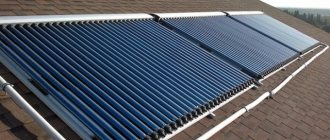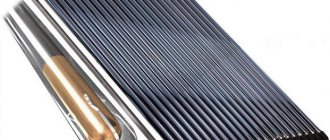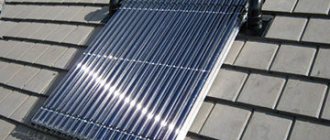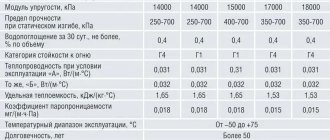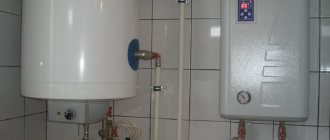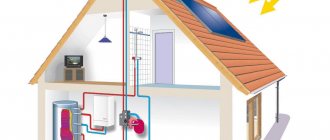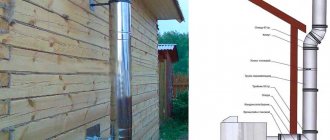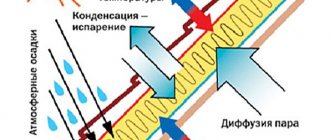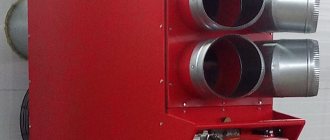Calculation of the actual power of the solar collector
Manufacturers indicate the maximum power of the solar collector at full illumination, facing south and oriented perpendicular to the sun at noon. But it is not always possible to direct the panels this way, especially if they are installed on the roof of a house.
Below are formulas that are universal and can be used both to calculate the number of collectors and to calculate the total area in square meters.
Calculation of solar collector efficiency by direction
The basic thermal performance of a solar flat plate or vacuum collector can be calculated using the following formula:
Pv = sin A x Pmax x S
Values:
- Pv – solar collector power;
- A – angle of deviation of the solar collector plane from the direction to the south;
- Pmax is the average insolation level in your region during the cold season.
Even if the sun is not hidden by clouds, the level of insolation changes throughout the day, which determines the performance of the collector. The average data can be seen in this graph:
The data in the illustration on the daily level of insolation are averaged, but they allow you to understand the difference between the amount of thermal energy that can be obtained at different times of the year.
The maximum level of insolation in winter is on average 3-4 times less than in summer. The amount of solar energy that a solar collector can receive per day in winter is 5-7 times lower (depending on latitude) than in summer.
Calculation of solar collector performance based on installation angle
The optimal angle for installing a solar collector for heating a house in winter is so that it is perpendicular to the sun's rays at 10 o'clock in the morning. This way it can collect maximum thermal energy during daylight hours.
Sometimes it is not possible to do this (when installed on the roof, mounted on standard supports). Due to deviations from the optimal angle, the energy efficiency of the collector may change. It can be calculated using the following formula:
Pm = sin(180 - A - B) x Pv
Values:
- Pm – solar collector productivity;
- A – angle between the collector and the ground plane;
- B – the height of the sun above the horizon at 10 am;
- Pv – previously found power.
If you have the ability to orient the solar collector so that it is perpendicular to the sun, then:
Pm = Pv
The photograph shows the angle of inclination of the solar collector, which must be used in the calculations.
Features of flat panels
A flat solar collector has small heat losses through the rear wall, which average 5 W per square meter. Therefore, from the previously obtained value of the real power P, it is necessary to subtract 5 W per square meter of area.
The solar radiation absorption level of a flat solar collector is below 100%. This must be taken into account when calculating its thermal power. If the panel absorbs only 95%, then its real power is:
P = Pm x 0.95 x S
Values:
- Pm – collector power from the formula above;
- P – real reservoir performance;
- S – collector area.
Vacuum manifold performance
Manufacturers of vacuum manifolds may specify the manifold capacity without taking into account the distance between the tubes. To determine the actual surface area of the tubes and the performance of the vacuum manifold, we use the formula:
P = Pm x D / L
Designations:
- P – actual performance of the solar collector;
- Pm – collector power, calculated earlier;
- D – diameter of vacuum tubes;
- L – distance between tubes.
Thermodynamic solar panels
With this type of collectors everything is much more complicated. Now they are not very common, manufacturers are experimenting with materials and selective coating. Different models differ in the level of absorption and heat loss.
In general, thermodynamic solar panels have the right to life. But we would not recommend installing heating with their help. There are few effective models on the market, and those that exist are sold at inflated prices.
What types of solar collectors are there?
There are two types of such systems: flat and vacuum. But, at their core, their operating principles are similar. They use the sun's heat to heat water. They differ only in the device. Let's look at the operating principles of these types of solar systems in more detail.
Flat
This is the simplest and cheapest type of collector. It works as follows: The metal body, which is internally treated with a highly efficient feather absorber to absorb heat, contains copper tubes. A coolant (water or antifreeze) circulates through them, which absorbs heat. Next, this coolant passes through a heat exchanger in a storage tank, where it transfers heat directly to the water that we can use, for example, to heat a house.
The upper part of the system is covered with high-strength glass. All other sides of the body are insulated with insulation to reduce heat loss.
| Advantages | Flaws |
| Low cost panels | Low efficiency, approximately 20% lower than vacuum |
| Simple design | Large amount of heat loss through the body |
Because of their ease of manufacture, such systems are often made even with their own hands. You can purchase the necessary materials at construction stores.
Vacuum
These systems work a little differently, this is due to their design. The panel consists of double tubes. The outer tube plays a protective role. They are made of high-strength glass. The inner tube has a smaller diameter and is covered with an absorber that accumulates solar heat.
This heat is then transferred to pullers or rods made of copper (they come in several types and have different efficiencies, we’ll look at them a little later). Heat extractors transfer heat using a coolant to a storage tank.
There is a vacuum between the tubes, which reduces heat loss to zero and increases the efficiency of the system.
| Advantages | Flaws |
| High efficiency | Higher price relative to flat |
| Minimum heat loss | Impossibility of repairing the tubes themselves |
| Easy to repair, tubes can be changed one unit at a time | |
| Large selection of species |
Types of heat removable elements (absorbers), out of a total of 5
- Feather absorber with direct-flow heat channel.
- Feather absorber with heat pipe.
- U-shaped direct-flow vacuum manifold with coaxial flask and reflector.
- System with a coaxial bulb and a heat pipe.
- The fifth system is flat-plate collectors.
Let's look at the operating efficiency of different absorbers, and also compare them with flat-plate collectors. Calculations are given for 1 m2 of panel.
This formula uses the following values:
- η is the efficiency of the collector, which we calculate;
- η₀ - optical efficiency;
- k₁ - heat loss coefficient W/(m²·K);
- k₂ - heat loss coefficient W/(m²·K²);
- ∆T - temperature difference between the collector and air K;
- E – total intensity of solar radiation.
Using this formula, using the data given above, you can do the calculations yourself.
Without delving into the variables, to put it simply, efficiency depends on the amount of heat absorbed by the copper heat sinks and the amount of loss by the system.
Systems with flow-through heaters or thermosiphon
According to their structure, they can be either flat or vacuum. They use the same operating principles. However, they have one significant difference in technical design.
This system can operate without an additional backup storage tank and pump group.
The operating principle is as follows. The heated coolant is accumulated in the base tank, which is located at the top of the system, usually 300 liters. A coil passes through it, through which water circulates from the pressure of the house’s plumbing system itself. It warms up and is supplied to the consumer.
| Advantages | Flaws |
| Low cost due to the absence of some equipment. | Low system efficiency in the winter season and at night |
| Easy to install, requires minimal effort, as the system is equipped with everything necessary |
How many solar collectors are needed to heat a house?
Regardless of what heating system is installed in the house, the heat loss will be the same. For an accurate calculation, it is better to contact specialists, but to obtain approximate data, you can use online services https://teplo-info.com/otoplenie/raschet_teplopoter_online.
By dividing the data obtained by the P value calculated using the last formula, you will find out how many solar collectors or square meters of collectors you need to heat your house in winter.
Separately, it is worth recalling that in the cold season there are nuances with the operation of solar collectors. You can find out more about this in the article “How a solar collector works in winter - efficiency, problems and their solutions.”
The main problem with the snake is cleaning the collectors from the cold.
Calculation of solar collectors for Irkutsk. In detail and with conclusions
Formulation of the problem
A kindergarten is being designed. During the heating season, DHW heating is carried out from heating networks through plate heat exchangers. Outside the heating season, the only source of energy is electricity, which is also “sparse”, since the power of the electrical input is limited. It is necessary to provide water heating for hot water supply from solar collectors - with electrical reheating if necessary. Well, since we spend money on collectors, we will use the heat from them during the heating season, if possible.
A little bit of theory
To understand further discussions, let's remember the basic terms and definitions. Very briefly, in a summary form. If you are “in the know”, feel free to skip this paragraph.
The solar radiation flux on the surface a) averages 1366 W/m2. Let me emphasize - specifically to the surface of the atmosphere, and not to the planet Earth itself. A maximum of 1000 W/m2 “reaches” the surface of the earth, this is already on the surface of the earth. The rest is scattered in the atmosphere and reflected into space. The greater the “thickness” of the atmosphere, the greater the scattering. We have the least amount of atmosphere at the equator when the sun is at its zenith. The closer the sun is to the horizon, the longer the path the solar rays have to travel, the “thicker” the atmosphere and the greater the scattering. The more cloudiness, the more scattering. The dirtier the air, the greater the dispersion. The actual intensity of solar radiation can drop to 50 W/m2 (overcast sky).
It is impossible to calculate the intensity of solar radiation flux in an arbitrary place on the Earth's surface, but there are observational data from hydrometeorological services in many cities on our planet, on the basis of which we can make calculations.
Scattered radiation, that is, reflected from the surface of the earth, water and clouds, is not lost. Both our body and solar collectors perceive it just as well. The share of scattered radiation in the total can exceed 50%. Therefore, even on a cloudy day, when the sun is not visible, the collector is still operational.
We will get maximum performance from the solar collector by placing its plane perpendicular to the sun's rays. But as the sun moves across the sky during the day, the collector's efficiency changes. The position of the sun also changes throughout the year. Nobody makes complex systems for positioning collectors (like sunflowers) - they are very expensive.
The task of the calculation is precisely to determine the optimal direction and angle of inclination of the collector in order to obtain maximum efficiency from it on average over the period of use. The optimal direction is simple - it's south. But with the angle of inclination it is more difficult.
Take, for example, Irkutsk - 52°16″ north latitude. The maximum altitude of the sun on the day of the summer solstice (June 21) is 61°. On the winter solstice (December 21st) - 14°. It would seem that if we position the collector at an angle of (61°+ 14°)/2 = 37.5°, we will get maximum performance for year-round operation. But everything is not quite like that; the “thickness” of the atmosphere and the share of scattered radiation are also taken into account. There is a simple recommendation - for year-round systems, the angle of inclination should be equal to the latitude of the area, and for systems operated only in summer - 15° less than the latitude of the area. But it’s better to calculate it anyway.
A collector is an imperfect thing, like all technology in our world. And it cannot utilize all the radiation falling on it; it can only use part of it. Accordingly, the collector has efficiency. If we do not take into account the heat loss of the collector, we will get “optical efficiency” or “maximum possible efficiency”.
The best collectors have an optical efficiency of about 80%. As we remember, 1000 W/m2 “reaches” the ground. Accordingly, such a collector will convert 800 W/m2 into heat (hereinafter, “square meter” means the area of the “absorber” or “absorber” of the collector).
It is from this figure that safety devices are calculated. The collector temperature is higher than the ambient air temperature. Accordingly, the collector has heat losses, which reduce its efficiency. These heat losses also need to be counted. At a certain outside temperature, heat loss will equal heat production, and the collector will become useless (this is where we “turn it off”).
There are two types of solar collectors - flat and vacuum. In vacuum absorbers, the absorber is located inside a glass flask in which a technical vacuum (or conditions close to it) is created, which significantly reduces heat loss, but increases the cost. For effective use in winter in most of Russia, only vacuum collectors are suitable. An excellent collector, located not on the equator, but in Germany, is capable of generating 600 W/m2. This figure is quite suitable for rough calculations and for selecting pipes and circulation pumps.
But these were all maximum, peak values. We are more interested in how much heat the collector will give us per day/month/year. Here we get the following figures, again for Germany:
- on a sunny summer day we can get up to 8 kWh/m2 from the collector;
- on a winter, no less sunny day - up to 3 kWh/m2;
- the total average annual radiation ranges from 950 to 1200 kWh/m2 (in the world from 800 in Scandinavia to 2200 kWh/m2 in the Sahara Desert).
As you can see, there is something to fight for.
Separately about stagnation
Solar collectors have a technical problem called "stagnation". This is probably the most significant technical problem. We cannot turn off the sun; we consume heat unevenly. Sooner or later a situation will arise when the collector begins to produce more heat than we consume. In this case, the temperature of the coolant will rise uncontrollably, and it will boil, after which the steam will squeeze the coolant out of the collector, and the circulation of the coolant will stop - that’s stagnation. Circulation will resume only after the collector has cooled and all the steam has condensed, that is, sometime during the night. Even if we urgently need heat, we will not be able to get it from the collector, since there is no circulation through it. And this is not the main disadvantage, the main disadvantage of stagnation is the degradation of the coolant.
The coolant (usually antifreeze) has a complex chemical composition and is sensitive to high temperatures. And the temperature of the coolant in summer can exceed 200 °C in a flat collector and 300 °C in a vacuum one. At these temperatures, chemical reactions between its components can (and will definitely begin) in antifreeze, with the formation of new chemical compounds. Insoluble sediment may form, viscosity may change, additives may break down, and the antifreeze may become aggressive. I have heard several stories from installers about how they cleaned the collector tubes of something that resembled “snot” and paraffin at the same time. What to do about it? Let's discuss below.
Irkutsk
Irkutsk is located in Eastern Siberia - 52°16″ northern latitude. Accordingly, the sun rises above the horizon by an angular amount from 14° to 61°.
I took the climate data from the reference book [1]. What was confusing was that the data in the directory was calculated for periods before 1980. What about global warming? I found more recent, although less complete, climate data in the RET Screen program (developed by the Canadian government and distributed free of charge at www.retscreen.net). A link to this program was contained in the textbook of the Faculty of Geography of Moscow State University [2], which caused my complete trust in it. The data in both sources differed slightly, and I decided to use the directory, since state examination was ahead of us, and experts treat Soviet-era directories better than Canadian-made computer programs.
A collector is an imperfect thing, like all technology in our world. And it cannot utilize all the radiation falling on it; it can only use part of it. Accordingly, the collector has an efficiency
Climatic data for Irkutsk are given in table. 1. What do we see in her? We see that the total input of solar energy on a horizontal surface on the average day of the month varies from 2.4 to 20.98 MJ/m2. And this is under average cloudy conditions. In my opinion - not bad. The average monthly outdoor temperature ranges from -20.6…+17.6 °C. Low temperatures, what can I say. And if we plan to use collectors in winter, we will have to use vacuum ones. Daylight hours in Irkutsk last from 8 to 18 hours. We also have data on scattered solar radiation. And we don’t need to know anything more about the climate of Irkutsk; we can move on to calculations.
Amount of solar energy and tilt of collectors
The available amount of solar energy will be determined according to the methodology given in the “Designer’s Handbook” [3]. The technique is quite obvious, but let's go through the steps with minimal comments.
Our task is to choose the number of collectors, their orientation and angle of inclination so as not to pay extra money and take maximum heat from the sun.
We will carry out calculations for the average day of each month (if we carry out calculations for each day of the month and average the results, we will get a value close to ours). All calculation methods known to me are based on this principle. I took the 21st of each month as the average day (all angles in the formulas, except hourly ones, are indicated in degrees). First, we determine the angle of declination of the sun on the calculated days:
where n is the number of the day of the year. Next, we find the hour angles of sunset (sunrise) for horizontal w3 and inclined w3′ surfaces:
Where ? — latitude of the area; ? — the angle of inclination of the collector to the horizon (to begin with, take it equal to the latitude of the area, then we will recalculate it).
Now let’s calculate the conversion factor for direct radiation from a horizontal to an inclined surface Rп:
Left a little. Let us find the ratio R of the amounts of solar energy supplied to the inclined and horizontal surfaces:
where E and Ed are the total solar radiation, direct and diffuse, respectively, MJ/(m2 year); ? — reflection coefficient for the underlying surface of the earth (in the presence of snow cover is taken equal to 0.7, and in its absence - 0.2). This formula is valid when the collectors are oriented strictly to the south. In our case, this is true. If this is not the case for you, enter the correction factor for azimuth; details are in the reference book [3].
Now we have everything to determine the average monthly daily amount of total solar energy arriving at the inclined surface of our solar collector:
Ek = RE, [MJ/(m2 day)].
Agree, so far everything is simple. A slight difficulty is that the calculation is iterative. At the first iteration, we determined the supply of solar energy at an angle of inclination of the collectors that is optimal for year-round operation. And you and I need the collectors to cover the daily need for hot water only in the summer months,
and in the remaining months - as best they can. Therefore, you need to carry out all the calculations for different angles, and choose from them the one at which the supply of solar energy in the summer months is maximum. I did this and the optimal angle was 35°. The calculation result is given in table. 2. The amount of solar energy entering our collectors varies from 143 in December to 435 MJ/(m2·month) in June. Agree, this is a lot. Here and further, when we talk about monthly figures, we are talking only about working days, since the kindergarten is not open on weekends. That is, we multiply daily indicators by the number of working days, not calendar days, in a month.
Efficiency of collectors and their number
Go ahead. Let's determine the real efficiency of the solar collector under the conditions of Irkutsk. Here we will already use the method from the collector manufacturer [4], and in our case the choice was made by the customer - we used Vitosol 300-T SP3A collectors from Viessmann with the following characteristics: absorber area - 3.02 m2; optical efficiency - 80.4%; heat loss coefficient k is 1.33 W/(m2 K2); heat loss coefficient k2 is 0.0067 W/(m2 K2);
This is all data from the technical data sheet of the collector. The formula for calculating actual efficiency is simple:
where ?T is the temperature difference between the coolant temperature in the collector and the outside air temperature, °C; Unit is the intensity (flux density) of the total solar radiation on the surface of the collector.
A couple of comments need to be made here. First, the radiation intensity is taken to be 800 W/m2. Why - I did not find an answer. If you know the answer, please share the information*. It seems to me that we should use the average value for the average day of a particular month. But “a technique is a technique,” we will use 800 W/m2. The second comment is that to determine the efficiency, you need to set ?T, which depends on the efficiency. The circle is closed. Where is the way out?
I propose the following line of reasoning. As you know, we heat hot water from 10 to 60 °C in summer (from 5 °C in winter). There is no point in heating it up to 50 °C at once - the collector field will be too large, it will be very expensive. We will definitely use buffer containers to heat the required daily volume of water during daylight hours. The coolant will be supplied to the collector inlet at different temperatures during the day, for example, during hours of maximum water consumption - at a temperature of 15 °C (10 °C tap water temperature plus 5 °C for the heat exchanger). This is the minimum temperature.
The rest of the time, the temperature will increase (along with the heating of the buffer tanks) until it becomes such that it will allow heating the water for domestic hot water to 60 °C. The coolant flow through the heat exchanger is fixed; for Viessmann it is 25 l/h per 1 m2 of collector absorber. At a solar radiation intensity of 800 W/m2, the coolant in the collector will heat up by 23 °C. Accordingly, the maximum temperature at the inlet to the collector will be 42 °C (60 °C “set point” for DHW plus 5 °C for the heat exchanger minus 23 °C). If the temperature rises further, the automation will turn off the heating, since hot water is no longer needed. In the stagnation protection mode, the heating will be turned on again, but we are not interested in the efficiency of the collectors in this mode.
In total, if we take the average temperature at the inlet to the collector as (15 + 42)/2 = 28.5 °C, then we will be close to the truth. It's summer. In winter it’s a little lower: (10 + 42)/2 = 26 °C. Accordingly, we will calculate the temperature pressure for each month based on the average temperature of the coolant in the collector at (28.5 + 23)/2 = 40 °C in summer and (26 + 23)/2 = 37.5 °C in winter. Further calculations are trivial. Knowing the actual efficiency of the collector, we can calculate the average monthly daily amount of utilized solar energy per square meter of collector area and determine the required number of collectors.
The coolant will be supplied to the collector inlet at different temperatures during the day, for example, during hours of maximum water consumption - at a temperature of 15 °C (10 °C tap water temperature plus 5 °C for the heat exchanger)
You can see the calculation results in the table. 3. The required amount of heat for DHW needs is taken from the data in the VK section. As we can see, the actual efficiency of the collectors varies from 68% in December–January to 76% in July (that’s why they are vacuum). And in order to fully ensure water heating from the sun in the summer, 43 collectors are needed. 40 collectors were accepted for installation. And this collector field of collectors is capable of covering 64% of the annual hot water demand.
Water heating circuit
The results of the calculations are beautiful and inspire optimism. But you still need to manage to take this amount of heat. I’ll briefly tell you about the principle of preparing hot water. You can see the diagram itself in Fig. 1.
What is good about this scheme is its high degree of heat recovery. When actively consuming water, we have the coldest water in the first container. If sensor D4 records the temperature in the collector higher than the temperature in tank No. 1 (sensor D1), pumps H1 and H2 are turned on, valve M1 directs the water flow to the side outlet, and tank No. 1 begins to heat up. As soon as the temperature of D4 becomes higher than the temperature of D2, valves M1 and M2 will switch (M1 is a direct outlet, M2 is a side outlet), and circulation will occur through tanks No. 1 and No. 2 sequentially. And so on.
As a result, heat removal begins at a coolant temperature at the outlet of the collector of only 25 °C with active water withdrawal. When the collectors overheat, the tanks are heated to 95 °C to protect the collectors from stagnation, while simultaneously solving the issue of thermal disinfection. The thermostatic valve at the system outlet reduces the temperature to a permissible 60 °C. If the heat from the collectors is not enough to heat the containers to the required temperature, then at night the electric heating is turned on, which will provide the required supply of 60-degree water by the beginning of the day. That's how it works.
It should be noted that in December and January it is problematic to effectively utilize heat from collectors, and that stated in the table. 3 During these months we will lose most of our thermal energy. Therefore, in further calculations we will assume that the collectors do not work during the two coldest months of the year.
Solar collectors and Rostekhnadzor
I have come across projects from very respected design organizations in which the authors classified solar collector pipelines as regulated hot water pipelines with all the ensuing consequences. It seems logical - the temperature in the collector during stagnation can reach 300 °C. But I disagree with the authors - regulated pipelines include those that transport (!) water with a temperature above 115 °C. In the case of solar collectors, if the collector overheats (above 105 °C), the automation turns off the circulation pump H2, and the transportation of the coolant stops. If you want to be on the safe side, add a thermostat that removes power from the H2 circulation pump when heating above 105 °C, with a lock that can only be removed manually (like the STB thermostat on hot water boilers).
If the heat from the collectors is not enough to heat the containers to the required temperature, then at night the electric heating is turned on, which will provide the required supply of 60-degree water by the beginning of the day. It should be noted that in December and January it is problematic to effectively utilize heat from collectors, and we will lose most of the thermal energy for these months
I also saw a project in which the authors classified these pipelines as process pipelines - group B category 5. Here we must remember that process pipelines are operated at hazardous production facilities (HPF). So you can go very far if every house with a solar collector on the roof is classified as a hazardous production facility. This is where the end of small-scale solar energy will come. Let us be “without fanaticism” in this matter. If we are talking about small-scale energy facilities, and not about industrial solar installations, then Rostechnadzor has nothing to do with us. The state examination of the project documentation agreed with me - at least there were no comments.
Once again about stagnation
We have already discussed that stagnation is evil. And in this project we are fighting it as best we can. True, we have only one tool for the fight - buffer tanks. Our task is to prevent stagnation and not lose thermal energy. This problem is similar to the problem about a swimming pool - heat from the sun flows into one pipe, heat flows out of another pipe into the hot water system, and the costs are different and change over time. We can’t overfill the pool (stagnation), and it shouldn’t empty (cold hot water supply). I found a graph of the hourly distribution of daily hot water needs for a kindergarten. The schedule itself is simple - there are three maximums (from 8:00 to 9:00, from 12:00 to 13:00, from 17:00 to 18:00), during which consumption will be 15, 21 and 16% of daily consumption , respectively. The rest of the time, consumption is quite uniform - from 2 to 5%. The graph of the distribution of solar insolation intensity within daylight hours is known - this is Fig. 2.
By superimposing these two graphs, we determined the volume of the pool, that is, excuse me, the buffer tanks. Three containers of 3 m3 each on the hottest summer day will be heated to 72 °C by 16:00 and to 79 °C by 19:00. This is provided that the hot water consumption is calculated. That is, on weekdays we will consider ourselves protected from stagnation. But on weekends there is nowhere to escape from it. I am far from thinking that a specially trained person will close the collectors from sunlight on Friday evening and open them on Monday morning. I also thought about the option of discharging the coolant from the collectors on the weekend, followed by filling it at the beginning of the week. For an industrial enterprise this would be a normal option. But the kindergarten does not have staff capable of regularly solving such problems. And without staff, I didn’t take the risk - I’m afraid the system will become airborne. Although this is technically feasible and quite simple. Vaillant even has a ready-made solution - auroSTEP self-emptying collectors. But this solution is for a small private house, not for a kindergarten. So, on the weekend we are defenseless against stagnation. The only thing we can do is to provide an expansion tank that will receive the coolant displaced by steam from the collectors. And maintain the coolant pressure in the collectors at the lowest possible level - so that the coolant boils at a lower temperature and degrades more slowly.
Economy
So we get to the most interesting issue - money (“No matter what they talk about, it’s always about money” - Todd’s second political principle). Further calculations, of course, are extremely simplified, but they will allow us to draw conclusions.
Let's look at the table again. 3. On average, the sun can cover 64% of the required thermal energy per year. We agreed above that in December and January our collector field hardly works, and we do not take into account the heat from it during these months. Then the annual coverage share will drop to 60%. Let's look at the local tariffs at which the kindergarten will pay for energy resources (the figures are current at the time of design): heat supply - 929.47 rubles/Gcal; electric energy - 0.72 rubles/kWh (no night tariff).
The duration of the heating season in Irkutsk is eight months, that is, for eight months a year, in the absence of the sun, we will heat water from heating networks, and for four months - with electricity. Accordingly, every gigacalorie produced by collectors in winter saves us 929.47 rubles, and in summer - 837.36 rubles. According to the same table. 3, in the winter months the collectors will produce 37.78 Gcal for us, and in the summer months we receive 37.31 Gcal from them.
Annual savings will be:
37.78 x 929.47 + 37.31 x 837.36 = 66,357 rubles.
At the time of design, the cost of one collector was about 150 thousand rubles. Let me remind you that the collector field includes 40 collectors. You can immediately conclude that there is no need to talk about economic feasibility at all. And, if not for a unique set of circumstances (the heating network does not work in the summer months, the electrical input power is insufficient, placing a boiler room on the territory of a kindergarten is undesirable, the customer has an interest in non-traditional energy sources), this project would never have taken place.
What if…
What will happen if: replace the collectors with cheap Chinese ones; replace the collectors with “non-vacuum” ones; replace the collectors with cheap Chinese “non-vacuum” ones; reduce the number of collectors; use the heat somewhere else; receive a state monetary award for the introduction of energy efficient technologies and thereby recoup the project; In a couple of years, collectors will become cheaper, and everything will be great?
The difference in the cost of equipment and the money saved is so great that this is all empty talk. But we haven’t yet discussed the cost of the remaining equipment and construction work. And the wage fund of a specially trained person who periodically cleans the collectors of snow and dirt. And the cost of service. And the cost of replacing antifreeze, which must be done every few years. And cheaper oil. And a rising currency. It seems like a big article, but so much was not discussed...
conclusions
1. The main conclusion is economic.
I see prospects only for ordinary, non-vacuum collectors, and only in sunny and warm climates, and only on small objects, such as individual houses. I don’t see any prospects for vacuum collectors in Russia. Discussion of the prospects for industrial solar installations is the topic of a separate article, and, alas, I am incompetent in this topic.
The difference in the cost of equipment and the money saved is so great that this is all empty talk. But we have not yet discussed the cost of the remaining equipment and construction and installation work, and the cost of service, and...
2. Calculation of solar collectors is very simple. For an engineer, of course.
3. Neither the collectors themselves nor the pipelines to them are supervised by Rostechnadzor.
4. Stagnation is evil. But we can and must fight it. Or at least adapt to it.
As always, I encourage you to challenge all of the above, but only within the framework of a respectful debate, with numbers and arguments. Speak up! I will be glad to change my point of view, especially on the first conclusion.
These things are really “cool”!
Shall we connect hot water supply?
In addition to heating, hot water supply can be connected to the solar collector system. To do this, let's calculate how much thermal energy you need to spend every day. The formula for calculating a solar collector for hot water supply is simple:
Pw = 1.163 x V x (T – t) / 24
Designations:
- Pw – amount of heat required to heat water;
- V – average volume of hot water consumed per day;
- T is the temperature to which the water needs to be heated;
- t is the temperature at which water enters the system.
To calculate the required number of additional collectors for hot water supply, divide this value by the performance of the solar collector P, obtained using the last formula.
Heat zones
Depending on the amount of solar radiation entering the Earth's surface, there are 7 thermal zones on the globe: hot, two moderate, two cold and two perpetual frost zones. The boundaries of thermal zones are isotherms. The hot zone is limited from the north and south by average annual isotherms of +20 °C (Fig. 9). Two temperate zones to the north and south of the hot zone are limited on the equator side by an average annual isotherm of +20 ° C, and on the high latitude side by an isotherm of +10 ° C (the average air temperature of the warmest months - July in the Northern Hemisphere and January in the Southern Hemisphere) . The northern border coincides approximately with the forest distribution boundary. The two cold zones north and south of the temperate zone in the Northern and Southern Hemispheres lie between the +10°C and 0°C isotherms of the warmest month. The two zones of perpetual frost are limited by the 0 °C isotherm of the warmest month from the cold zones. The kingdom of eternal snow and ice extends to the North and South Poles.
Tips for heating a house with solar collectors
- Flat-plate solar collectors are more efficient in the warm season, and vacuum tubes are more efficient in winter. Depending on the model and manufacturer, the difference can reach 50%. You can read more about this in the article “Solar collector – flat or vacuum?”.
- In case of an unforeseen situation, it is worth having alternative sources of thermal energy - convectors, gas or solid fuel boiler, heat pump.
- Typically, collectors are supplied with separate storage tanks. It will be more profitable to purchase separately flat or vacuum panels and one or two large tanks with good thermal insulation. The smaller the tank volume, the faster it cools.
- To organize efficient heating, it is worth having a large storage tank, in which collectors will heat water during daylight hours, and at night it will be used to heat the building.
- The presence of a high-quality controller in the heating system will allow you to maintain the set temperature, regulate circulation, set temperature conditions, and set the on timer.
- To autonomously heat a house with solar collectors, you need to buy a large amount of equipment, pay for its installation and connection. If you can’t afford it, you can use solar collectors as an auxiliary heating system.
- Good savings can be achieved if you use solar collectors paired with a heat pump. They will heat the water, and the heat pump will heat it to the required temperature.
- If the building is poorly insulated, then it is more effective to use solar collectors with water heated floors. It transfers maximum heat to the room, and not to the walls, like heating radiators.
As you can see, calculating solar collectors for heating a house is quite simple. Of course, the specialist will have to consider many other nuances, but they will not be able to significantly affect the final result. In some cases, heating a building with collectors is impractical, but as an additional source of free heat, solar collectors are irreplaceable.
Don't forget to share the post on social networks!
Loading…
Types of collectors
The calculation of solar collectors for heating is based on their specific type, so it is very important to choose the right type of device used.
There are three main types of collectors: flat plate, vacuum and air. Having examined each of them in detail, you will certainly be able to accurately calculate the solar collector for heating. This will also help you choose the right type of solar water heater. It is the operating principle of a flat-plate collector that is most similar to what we described above. This manifold consists of a flat box covered with protective glass, inside which propylene glycol circulates in copper tubes, transferring heat to the tank.
Instead of a flat sheet, a vacuum solar collector for heating is made up of large tubes with a cavity and several smaller tubes inside. These small tubes contain a substance that accumulates thermal energy. Then this kind of battery transfers energy to the coolant, after which everything proceeds according to the standard operating principle. Vacuum acts as a heat insulator inside large tubes, hence the name of this type.
The air solar collector for heating is used less often than others, since its efficiency is much lower. The reason for this lies in the fact that air acts as a coolant, and it transfers heat worse than liquids. On the other hand, much less energy is spent on its transfer. In some cases, this process occurs naturally, which not only saves electricity, but also reduces the amount of noise produced.
How to make a solar collector with your own hands, watch the video:
